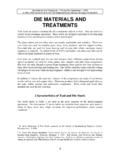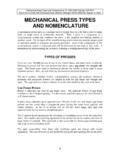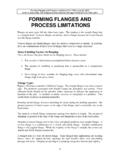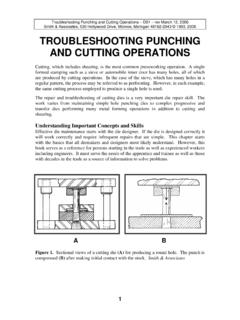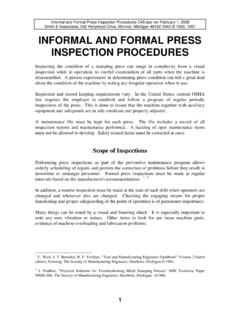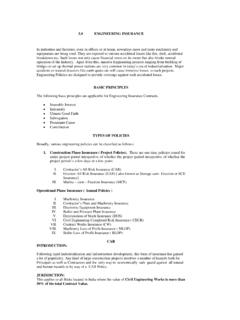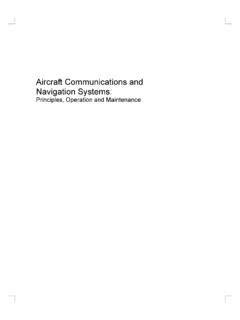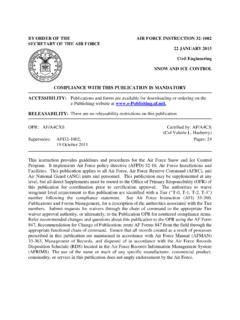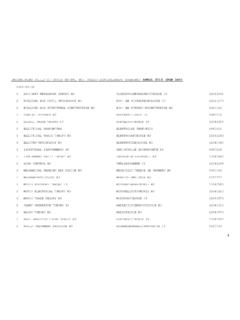Transcription of Basic Principles of Press Force Monitors - Smith & …
1 Basic Principles of Press Force Monitors REV March 11, 2005 Smith & Associates, 530 Hollywood Drive, Monroe, MI 48162-2943. 1989-2005 Basic Principles OF Press Force Monitors Calculating the tonnage or Force required for a pressworking operation can be done by careful analysis of the material properties and sequence of work done in the die. This is normally done by the die designer or tooling engineer in order to specify the correct Press for the job. However, the tool engineer is not the person who is going to set up and operate the Press . Changes in material properties, tooling wear and errors in engineering calculations can all cause the actual Force requirements to vary greatly from calculated values.
2 Advantages of Force Monitoring There are actually pressworking operations so precise that a mechanical engineering degree is a requirement to setup and operate the machine. However, the vast majority of presses are set-up and operated by persons having no formal engineering training. They have learned the job by experience. Example of a Mechanical Force monitor Figure 1. A dial indicator mounted on a Press column used as a mechanical Force indicator. Smith & Associates Force monitoring is an excellent pressworking process and control tool. It is an aid to achieving setup repeatability and pinpointing problems.
3 To achieve maximum 1 Basic Principles of Press Force Monitors REV March 11, 2005 Smith & Associates, 530 Hollywood Drive, Monroe, MI 48162-2943. 1989-2005 utilization, training in the theory and operation of the monitoring equipment is essential. Essentially all modern Force monitoring devices employ some form of mechanical displacement transducer that provides an electrical signal that varies in accordance with a change in strain or displacement. These devices are generally called strain gages, strain sensors, strain transducers, or strain links. Force Measurement Historical Development An old concept is the measurement of operating forces of presses.
4 Hydraulic Press forces are easily measured directly from the fluid pressure applied to the cylinder. Usually, the gauge is calibrated to indicate both the fluid pressure and the equivalent Force based on the piston area. The Force developed by a single cylinder hydraulic Press can be measured accurately. The main sources of error are attributable to friction in the cylinder packing and slide guiding method. The accuracy of the gauge must also be considered. If the Press Force is in the top third of the capacity range, actual gauge readings will typically be within 2% to 5% of a true reading. The errors are likely to be greater at forces that are a small percentage of the Press total Force capacity.
5 This is because friction in the cylinder is a larger percentage of the developed Force . In addition, the pressure gauge accuracy is usually given as a percentage of full-scale reading. The accuracy of low gauge readings depends upon factors such as scale printing errors and how linear the mechanism is in mechanical gages. Mechanical Strain Measurement An old method for determining operating forces by means of measuring the displacement of a straightside Press housing is illustrated in Figure 1. The housing or column together with the crown and bed are held in compression by prestressed tie rods. As the Press is cycled through bottom developing Force , the preload on the columns is partially relieved.
6 Either a dial indicator having built-in mechanical amplification or a vernier scale is used to determine the mechanical displacement of the Press column. Practical dial indicator systems incorporate a second pointer to retain the peak reading. Vernier scales provided with a mechanical decoupling device to store the peak reading could be used. This system was historically useful for Press development and analysis of problem processes. It has been supplanted almost entirely by electronically amplified strain sensors. Early Electrical Strain Measurement Charles M. Kearns, Jr. is considered the inventor of the bonded electric resistance carbon strain gage.
7 Prior resistance strain gages were carbon-base paints applied as liquids. Charles joined the Hamilton Standard Company in 1936 and was assigned the problem of correcting propeller blade fatigue stress failure in flight. 2 Basic Principles of Press Force Monitors REV March 11, 2005 Smith & Associates, 530 Hollywood Drive, Monroe, MI 48162-2943. 1989-2005 The strain gages of the day were either mechanical or carbon-base paints applied as liquids. Charles applied his amateur radio experience with carbon resistors to devise a better restive gage. He simply ground a carbon resistor down and cemented it to a beam. He found as the beam was deflected, the resistor changed resistance with strain linearity.
8 This invention was put to use in late 1936 and enabled the development of better aircraft propeller designs. On the eve of World War II, it gave the Allies their first reliable means of measuring in-flight strains and resulted in superior aircraft designs. The bonded carbon gage was used into the 1940s. It was supplanted by the resistive wire strain sensor simultaneously invented by Edward E. Simmons, Jr. and Arthur C. Ruge in 1939. Some Electronic Strain Sensors Used in Pressworking Several types of strain sensors are used in pressworking applications. Strain sensors provide an electrical signal that is directly proportional to the mechanical displacement being sensed.
9 The most familiar device for pressworking applications is the strain sensor or strain link used for tonnage monitor applications. The strain link has a rugged housing containing a calibrated assembly incorporating one or more strain gages. Most tonnage meter installations require one strain link per channel of information. To provide a useful output, strain links or transducers must be installed on the Press at a location where the change in reading is proportional to the change in tonnage in the die space. The most popular location on straightside presses is the Press column upright. The strain transducer is also mounted to the frame of gap presses.
10 Most strain sensors mount by means of screw attachments and are generally interchangeable with another of the same type without need for recalibration. Several types of strain sensing elements are used to construct pressworking strain transducers. Foil Strain Gages The modern foil strain gage evolved from the resistive wire strain sensor simultaneously invented by E. Simmons and A. Ruge in 1939. An agreement to jointly share the patent was agreed. The patent negotiations and early production of the wire strain sensor was by the Baldwin Lima Hamilton (BLH) Locomotive Company. The Baldwin Lima Hamilton interest in the strain gage had several driving factors.
